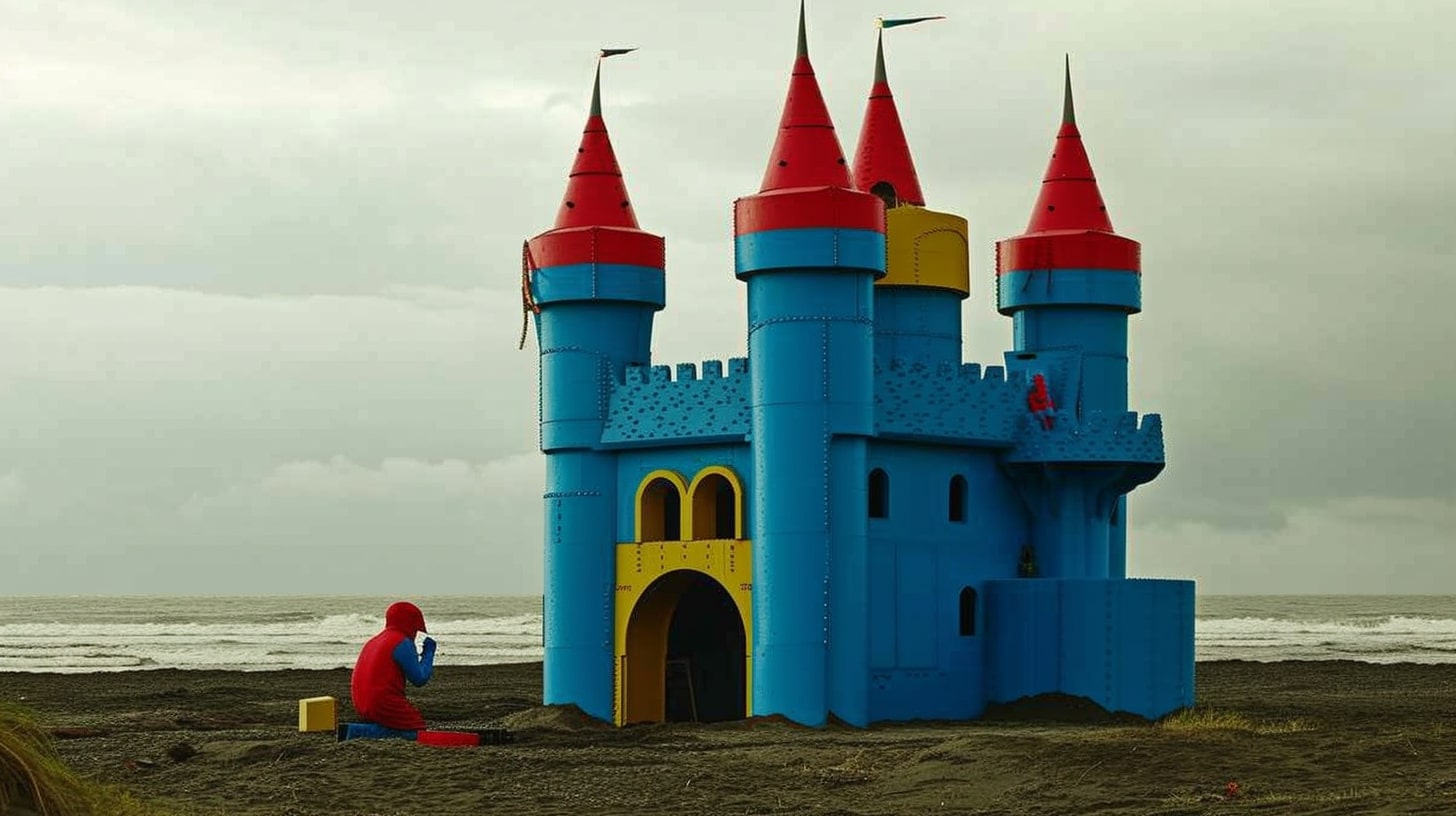It’s kind of weird to think depending on when you were born and what you grew up around, the idea of a one person business seems either totally feasible or completely impossible.
I grew up in 1980 to show my age and for the first 20 years of my life, there was no such thing as a one person business unless you knew how to make your own drugs.
The Internet has changed that. The Internet has allowed people to decide how they want to build their businesses. You can try and build an empire with 1000s of employees or you can decide that you only want to work with yourself.
And it doesn’t matter.
Whether you succeed or fail is not going to be determined by the number of employees you have and that’s a beautiful thing.
But the question then becomes how do you build a one person business? To figure that out first we need to understand how any business finds success.

Why Businesses Fail
There are two key principles that I follow when building any type of business.
By following these two things you can see if a business will succeed or fail. Let’s look at both real quick.
The Pocket Business Formula
Audience x Offer = $$$$$Every business in the history of business follows this formula. To build a successful business the only thing you need is to increase each variable.
That’s it.
This is why it’s possible to build a one-person business because you just need to figure out how to get customers (audience) in front of an offer that they want.
The toughest challenge is the audience variable. Finding people who care about what you do. So how do you do that?

The Pocket Business Framework
We are in the Attention Economy and therefore attention is the currency. The framework to follow to ensure you’re getting the attention of the right people is this.
- Get them to notice you
- Get them to pay attention to you
- Get them to trust you
- Convert that trust into money
This is the Pocket Business Framework. If you’re struggling to build a business then it’s because you can’t walk people through these steps.
Strategy vs Tactics
Now that you understand The Pocket Business Formula and The Pocket Business Framework, you should be able to see that there are a million different ways to apply them.
You can consider these two principles as strategies. They never change. They are eternal truths.
Tactics are the actions you take to try to get the most out of a strategy. So when you’re sitting around asking how do you get 10,000 followers on Instagram and a guru pipes in that you just need to post 3x a day, that’s a tactic.
But that tactic is only effective if it helps to strengthen the Pocket Business Framework. This is why you can’t get too tied up in the idea of finding the magic tactic that will work.
Let me give you an example.
Melissa Neill was a student of mine. One of the things that I encourage most people to do is start a blog. It’s great to build a long-term resource that can go deeper into things that your audience needs help with.
However, Melissa was better suited for video so we moved her over to YouTube and TikTok where she quickly built an audience. Does this mean the right tactic for everyone is YouTube or TikTok?
Not at all. It’s just the platforms that were most effective for her in implementing the Pocket Business Framework.
Now she is doing over $40,000 a month by following a system but adjusting the tactics.
Always stick with the strategy but adjust the tactics when needed.

Traffic Types: Long-Term vs Short-Term, Active vs Passive
When it comes to building an audience you need traffic. There is no hiding from it but it’s important to understand the different types of traffic that you’ll be chasing.
A lot of people want to stick with social media and for good reason. There are millions of success stories of people building amazing businesses off the backs of their social media profiles.
But social media traffic is both Short-Term and Active.
What this means is that every post that you create on social media has a short lifespan. It’s why people are constantly trying to go viral every single day and seem to live and breathe by how well their numbers are looking tomorrow.
It’s also active traffic. You have to remain active on social media in some capacity if you want to get anything out of it.
You can do well only focusing on social media. Plenty of people have, but because it is Short-Term and Active, burn out is likely.
Do you want to spend the rest of your life always focused on social media? This becomes even more difficult with a one person business that requires other things to be working as well.
Long-Term traffic is the traffic where you post something and it can generate an audience for months or years. You see this with blogging and YouTube. It also means that this kind of traffic passive.
If you do well with SEO then you can have 100s or 1000s of your posts rank in the search engines which will drive traffic to your site. You don’t need to be around for it.
In this situation it seems like it’s best to focus on Long-Term/Passive traffic but the problem with doing that is takes time to ramp up and if you have the patience to wait for money then that’s fine.
But if you want to make money as quickly as possible without burning out in the long run then you want to find a balance between Short-Term/Active and Long-Term/Passive traffic building.
Let me show you the approach that I take.

Starting a One Person Business
First, why one million dollars? That seems like a lot of money to try to get and it depends on your mindset. But the real reason why this plan is for at least one million dollars is pretty simple.
If it can work for one million dollars then it can work for anything below that. Why should the $1,000-a-month plan differ from the million dollars in a year?
To start you need to figure out what you’re going to do. Before you paralyze yourself with fear let’s make this easier.
Help People Get More of 1 of these 3 Things
People are pretty simple. We want to pretend that we are complex, but we are as simple as simple can be. What we want most in the world can be boiled down to 3 things:
- More Love
- More Money
- More Health
That’s it.
In some form or another everything that we do revolves around these 3 things. It’s not always obvious how, but if you see the world this way then it becomes a lot more obvious in what type of business you should build.
If you can help someone get more of one of these things, I call them the 3 Egos, then you’ll make a lot of money.
So when it comes to thinking about a niche, this how you should think about it. Which one of these 3 things do I help people get more of? That’s my niche.
Don’t think of your niche as a topic or a person. Think of your niche as an outcome and that will allow you flexibility in the future with how you wish to move.

Figure Out the System to Getting More
We talked about systems already. This is where you get to use your brain and figure out the system that helps someone get more of one of the 3 Egos above.
This is the fun part because sometimes it requires experimentation and other times you already know it.
For example, let’s look at more health. How can people achieve more health? To you, the system might be to always get X amount of minutes of exercise per day.
Let’s say the number is 47.
If you can get 47 minutes of exercise every single day you will live longer. From there you can find a million different tactics that will help people achieve 47 minutes a day.
That is the mechanism.
Figure Out the Mechanism (Tactics)
You decide that your mechanism is helping people walk 47 minutes a day no matter where they’re at or the weather. Every single day they’ll get 47 minutes of walking in.
This is the foundation of your business all set.
Unfortunately, this is where a lot of people stop because they think the only thing they need to do is show people that they can get them more health by walking 47 minutes a day.
But what happens when other people begin to teach the same thing? This is highly replicable and it’s also why you shouldn’t get upset if others copy you.
If you’re doing a great job then it’s bound to happen.
This is why you then move onto the Big Idea.
Figure Out the Big Idea
This is the hardest part of this sequence. Trying to figure out The Big Idea. Now, I will say that making money doesn’t require you to have a Big Idea, but I do believe over a long period of time, building something consistent is much easier with a Big Idea.
Why?
The Big Idea is something that your Tribe can get around. It’s what unites them and very few people are into the business of building tribes because they are so focused on conversions. But the best way to make money is to get the same people to continue to give you money.
This is a lot easier when they feel they are part of a tribe and a tribe is only united around a singular cause.
Just Do It. Think Different.
Iconic and helped to build some of the world’s largest companies.
But again, this doesn’t need to be figured out right away. It’s just something to keep in mind because many of you will arrive at a place where you think you’re doing everything right, but for some reason someone else is finding success when you’re not.
Even when you’re doing the exact same things as them.

These Are the Foundational Elements
What we have now are the foundational elements.
- The Niche (the outcome)
- The System
- The Mechanism
- The Big Idea
You might be wondering when does the actual business-building happen and that is next. But look at the 4 things there and you can start to see that there are a million ways you can get these concepts out into the world.
If someone tells you that LinkedIn is the way to go but you hate LinkedIn and don’t feel it’s right for your audience, then guess what? Find somewhere else. It doesn’t chance any of the foundational things set above.
How to Build a Million Dollar One Person Business Model
Now with the foundation set let’s explore how to build this out. It’s important to keep in mind that what I’m going to show you are the tactics that I use for all of my brands and the clients that I help.
It’s how I do things because I’ve found they work well with how I think and they help to implement the systems that we’ve set in this post.
Step 1: Website and Blog (or BVA)
I like to have a base of operations. Somewhere that people can go to and reference. I don’t use any of the social link services (like Stan Store or Linktree) because I want people to get use to coming to my site.
Next, I either create a topic cluster with a blog or set up a Big Value Asset. There are a couple of reasons for this:
- I want to get Google indexing the site and its content as quickly as possible. The longer I take to get some type of content up, the longer it will take to generate passive traffic.
- I want to create a resource that my audience can go to. It’s always a small percentage of your audience that will go to your site and explore, but those usually end up being the people that buy from you.
- It helps me to clarify my thinking around the topics that I want to discuss with my audience on other platforms.
At most, getting this set up should take me a week. A weekend is preferable. It doesn’t mean I complete every single blog post in that time. Blogging is an eternal task (though not a daily one).
With Pocket Business, instead of starting with a blog I went with a BVA which was the Pocket Course. With Odd Noodle, I started with a lot of blog posts because I really wanted organic traffic to be the driving force behind that brand.

Step 2: The Offer
What problem am I going to solve for my audience and what is the delivery mechanism for it.
With Pocket Business, it comes in the form of a service and a course. With Drooling Sloths it comes in the form as a service.
If it’s an offer, then it has to be something that I can create in a weekend. Many times this will be a book, but sometimes it’s a workshop.
More importantly, I get the sales page up. It doesn’t matter if I plan on driving traffic to the page immediately or later. I need to get a sales page to help set the direction of where I’m going with things.
Step 3: Write the First 10 Emails
You live and die by your mailing list. There is no reason to wait to start one. Start one today. It doesn’t matter if people are on it or not.
Instead of trying to figure out what to write each week, I’ll come up with a sequence of emails that I can load up and send when needed.
Sometimes they’ll be in an automated sequence while other times they’ll be sent weekly as a broadcast.
But the last thing I want to do is get people to sign up for a mailing list and not receive emails for weeks or months.
Intermission
It’s important to understand what we’ve done so far in these steps. We’ve established a way to get long-term/passive traffic with blog posts and/or a BVA.
We’ve created some type of offer that will start to bring in money and we’ve created emails to keep the attention of the audience.
If this is all we had then we could run this as a business and over a period of time, assuming we are doing things correctly, it would work.
We would continue to write blog posts and send out emails.
One person can do that. But we need to add another element because we need to go out and meet our people where they are at.
Step 4: Social Media
It might seem weird to think that social media falls way down here, but the truth is that everything above is a week’s worth of work.
But what it does is set the tone for the social media content so instead of posting random things, there is some world-building that is happening.
The people that come across my content on social media and resonate with it can then go to the site and not feel out of place.
Each interaction that we have leads them further into my world where they get closer to buying an offer when they are ready. More importantly, it helps me keep a single narrative so I don’t stray and lose sight of who I want to attract as a customer.
Remember, this is about a one-person business. Not a team of people that run off doing random experiments.
The Flywheel Is the Key
Have you ever seen a flywheel? It’s a machine that is hard to start but once it gets moving it’s almost impossible to stop.
The goal with this system is to build a flywheel where there isn’t much effort required to keep it moving.
- Use social media and SEO to get people to the site and sign up for the mailing list
- Use the mailing list to continue keeping their attention and building their trust
- Evergreen offers that allow for money to be made daily
You can make the system as simple or as complicated as you want to make it. Can one person do this?
You already know what the answer is.
Because of the blog posts, over time there isn’t a need to be on social media daily. There is no panic that the algorithm will forget about you.
Let’s imagine a perfect system.
- 100 blog posts on a site. These posts are SEO-optimized so all of them are ranking for some keywords. These drive traffic to the site every single day.
- 52 emails in the system. One email a week (you can decide the frequency) that sends people back to the site or your social media. This reiterates to your audience that you can be the trusted guide for them. The emails also remind them of the offer(s) that you have.
- 52 social media posts. One social media post a day that reinforces your Big Idea and everything else.
- 3 offers. Low-ticket, medium-ticket, high-ticket. All selling daily.
What part requires the help of someone else? I’m not writing this post to discourage you from hiring or seeking help. I just want you to see how it’s possible for one person to find success as long as they have a system in place.
The challenge is always in getting the flywheel started. There is no set amount of time it takes to make this happen. For some people it happens in a matter of weeks while others take years.
Why the difference?
It comes down to how well you’re able to attract people to you. I’m not saying a lot of people, but the right people.

What Do You Do Now?
The biggest challenge is time. It’s obviously easier to get all of this up and running if you have no other responsibilities, but these steps were created with the busy person in mind.
With this in mind you can check out the free course to dive deeper into a lot of the principles touched upon in this post.
Or you can get a major jumpstart to things by having me build the foundation of your Pocket Business.
